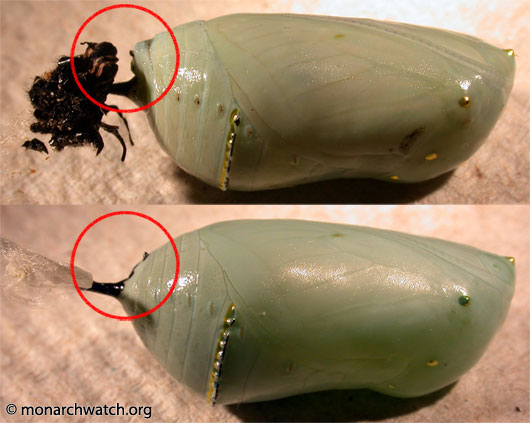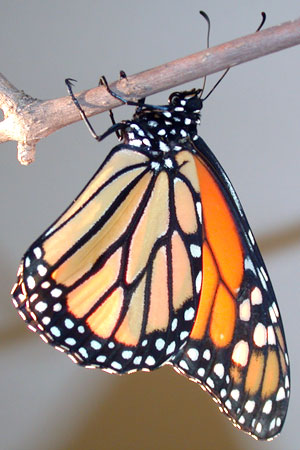Black Dots on Monarch Pupae
Wednesday, August 12th, 2009 at 1:38 pm by Jim LovettFiled under Monarch Biology | 3 Comments »
Ann made an interesting observation in the lab this week concerning the black dots that appear close to the cremaster on a monarch pupa. The cremaster is the black “stalk” that attaches to the silk pad spun by the caterpillar prior to pupation. You may have seen this graphic I posted some time ago, showing how you can tell the sex of a monarch pupa (due to the presence of that little line you can tell this one is a female):

You can clearly see the series of paired black dots and it is the pair on the far right that is the subject of Ann’s observation. Note that this last pair of “dots” appears to protrude a bit from the surface of the pupa, whereas the other dots appear “painted” on the surface.
We raise lots of monarchs and occasionally see various issues with pupation – one of those being incomplete shedding of the caterpillar skin. In some cases, a monarch that is unable to completely shed its skin will not be able to attach to the silk pad with the cremaster and the crochet hooks of the cremaster become embedded in the partially shed skin instead.
Due to the large number of monarchs we are raising in preparation for the fall, Ann is seeing quite a few of these and she noticed that these “stuck” pupae tend to be slightly misshapen. In most if not all of the cases where the skin is only partially shed, the area around these black dots is noticeably raised in appearance:

Upper: “stuck” monarch pupa; Lower: “normal” monarch pupa. Photos by Jim Lovett.
Do these features of the pupa play some role in pupation? Perhaps. It certainly looks as if they are the last contact point between the pupa and caterpillar skin as the cremaster emerges and is thrust into the silk pad.
This is something we’ll have to investigate further when we have time but it is quite an interesting observation, don’t you think?
By the way, this particular pupa’s deformation appears to have had no negative impact on its development – as I entered my office this morning I was greeted by a newly emerged male monarch butterfly:



3 Responses to “Black Dots on Monarch Pupae”
By Jacqui on Aug 13, 2009
Hi Jim
That’s fantastic – very interesting observation, Ann. Wonderful photographs.
We keep on learning! (The more we learn, the more we don’t know, hehe.)
Jacqui
By Mona on Mar 10, 2011
During pupation, the outer skin does hang on until the caterpillar has hooked the cremaster into the silk pad. Then it gyrates until it loosens that connection. Great observation. I agree that the black dots are probably the previous connection prior to the hooking of the cremaster. Sometimes that connection fails and then if the caterpillar does not hook the cremaster fast enough it will fall.
By mike skoczylas on Jul 14, 2012
beginning my third summer of collecting/raising; second summer tagging. Two questions: while hunting, have NEVER seen a chrysalis on a milk or butterfly weed leaf. even while raising, the chrysalis is either on the side of the container or on the netting covering the container. 1) in the wild, where do monarchs attach their chrysalis? should I be looking someplace else? 2)have an abundance of both milk and butterfly weed this year in Waystation, but drought-like conditions in northern Indiana persist; have only seen 6 monarchs this entire year. apparently no relief in sight from dry and hot weather. how will these conditions potentially impact migration to northern indiana? (stop migration and stay in more suitable environment/migrate through/ no change…what is anticipated? has this ever happened before? many thanks, mike 7-14